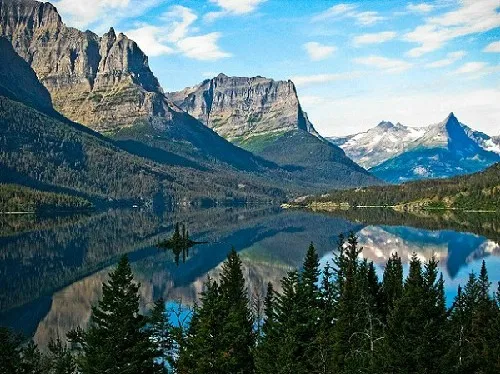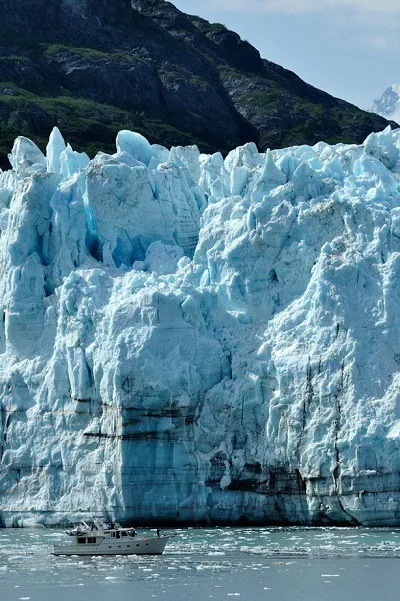Montana, nicknamed the “Treasure State” or “Big Sky Country,” has long been celebrated as a gem of the United States, especially for those who are captivated by the raw and majestic beauty of nature. Beyond the magnificent Glacier National Park, Montana harbors countless wonders, from towering rocky mountains and crystal-clear lakes to vast primeval forests and diverse flora and fauna. If you are a nature enthusiast seeking a destination to satisfy your passion for exploration, Montana is undoubtedly an unmissable choice.
Montana welcomes visitors with a vibrant tapestry of nature, where each season offers a unique charm. Summer is ideal for trekking, hiking, and exploring national parks. Autumn adorns the landscape with the fiery gold of maple leaves, creating a romantic and poetic setting. Winter transforms Montana into a ski paradise with world-class resorts. No matter when you visit, Montana always has unique and memorable nature experiences to offer.
Discover the Majestic Beauty of Glacier National Park

Glacier National Park, known as the “Crown of the Continent,” is a must-visit destination in Montana. With over 700 miles of hiking trails, from easy lakeside paths to challenging mountain climbs, Glacier caters to all levels of experience. You can choose to hike the famous Highline Trail, admire panoramic views of Lake McDonald from the summit of Mount Oberlin, or explore the pristine beauty of the Many Glacier Valley.
Lake McDonald, the largest lake in the park, is an ideal stop to relax and enjoy the stunning natural scenery. You can rent kayaks or canoes to explore the turquoise waters, or simply sit by the shore and admire the majestic mountains reflected on the lake’s surface. In summer, you can join boat tours on the lake to learn more about Glacier’s history and unique ecosystem.
Another unmissable experience in Glacier is driving the Going-to-the-Sun Road, one of the most beautiful scenic drives in the United States. This 50-mile road takes you through breathtaking landscapes, from lush pine forests and cascading waterfalls to snow-capped peaks. Stop at Logan Pass, the highest point on the road, to take in panoramic views of the park and breathe in the fresh mountain air.
For wildlife enthusiasts, Glacier is a true paradise. The park is home to many rare species, including grizzly bears, mountain goats, bighorn sheep, white-tailed deer, and bald eagles. Bring binoculars and a camera for a chance to capture memorable moments when encountering these wild residents in their natural habitat.
Immerse Yourself in the Wonderful Natural World of Yellowstone

Although most of its area is in Wyoming, a significant portion of Yellowstone National Park extends into Montana, offering visitors the chance to explore the unique geothermal wonders and diverse ecosystems of America’s most famous national park. The Montana section of Yellowstone is concentrated in the north and west, where you can find stunning hot springs, geysers, and lakes.
Mammoth Hot Springs, located at the north entrance of Yellowstone, is a fascinating destination with white travertine terraces formed over thousands of years by mineral-rich hot water. You can walk along the boardwalks to admire these unique geothermal structures up close and learn about their miraculous formation process.
Gardiner, Montana, the north gateway town to Yellowstone, is an ideal stop to prepare for your park exploration. This small town offers a friendly and cozy atmosphere with many restaurants, souvenir shops, and tourist services. You can also visit the Roosevelt Arch, a historic stone arch marking the north entrance to Yellowstone.
Yellowstone Lake, the largest freshwater lake in North America located atop a volcanic caldera, also extends into Montana. This vast lake is home to many species of fish and waterfowl, and it’s an ideal location for kayaking, fishing, and watching stunning sunsets.
The Montana area of Yellowstone is less known than other areas, but it offers a more peaceful and intimate experience with nature. This is a great opportunity to escape the crowds and explore the hidden corners of Yellowstone, while enjoying the unspoiled beauty and tranquility of Montana.
Relax and Enjoy the Poetic Beauty of Flathead Lake
Flathead Lake, the largest natural freshwater lake west of the Mississippi in the United States, is located in Northwest Montana, near Glacier National Park. With crystal-clear waters and surrounded by majestic mountains, Flathead Lake is an ideal destination to relax, enjoy water activities, and explore the poetic natural beauty of Montana.
In summer, Flathead Lake becomes a paradise for water sports. You can swim in the cool waters, kayak or canoe to explore the small bays and beautiful islands on the lake. Fishing is also a popular activity on Flathead Lake, where you can catch various types of fish, including cutthroat trout, lake trout, and northern pike.
Around Flathead Lake are many beautiful small towns and villages, offering visitors the opportunity to explore local culture and enjoy the distinctive cuisine of the Montana region. Bigfork town is famous for its professional arts theater and annual Cherry Festival. Polson, located at the south end of the lake, is the commercial and cultural center of the Flathead Indian Reservation. Whitefish, a popular resort town, is near the Big Mountain ski area and offers many year-round outdoor activities.
Wild Horse Island, the largest island on Flathead Lake, is a wildlife sanctuary, home to a famous herd of wild horses. You can take boat tours to the island to see the wild horses in their natural environment and explore the unspoiled beauty of the island.
Immerse Yourself in the Wilderness at Kootenai and Lolo National Forests
Montana is not only famous for its national parks but also boasts vast and pristine national forests, offering visitors the chance to explore diverse nature and engage in exciting outdoor activities. Kootenai National Forest and Lolo National Forest are two of the most outstanding national forests in Montana.
Kootenai National Forest, located in Northwest Montana, bordering Canada, is a wilderness area with high mountains, clear lakes, and dense forests. This forest is home to many wildlife species such as black bears, elk, gray wolves, and lynx. You can explore Kootenai by hiking hundreds of miles of trails, fishing in lakes and rivers, or camping under the starry sky.
Lolo National Forest, located in Western Montana, stretches from the Idaho border to near Missoula. Lolo is famous for its diverse scenic beauty, from towering granite mountains to lush green valleys and winding rivers. This forest offers many exciting outdoor activities such as hiking, rock climbing, mountain biking, fishing, and kayaking. The Lolo Trail, a historic 97-mile trail, passes through Lolo National Forest, offering visitors the opportunity to explore the history and nature of this land.
Conquer the Majestic Montana Rocky Mountains
The Montana Rocky Mountains, part of the vast Rocky Mountains range, are one of Montana’s natural icons. With towering peaks, turquoise glacial lakes, and deep valleys, the Montana Rockies are an ideal destination for those who love mountaineering, skiing, and wilderness exploration.
Big Sky Resort, the largest ski resort in the United States, is located in the Montana Rocky Mountains, offering visitors a world-class skiing experience in winter. In summer, this resort becomes an attractive destination for outdoor activities such as hiking, rock climbing, mountain biking, and ziplining.
Whitefish Mountain Resort, another famous ski resort in Montana, is located near the town of Whitefish and Glacier National Park. This resort offers excellent skiing in winter and exciting summer activities such as hiking, climbing, and downhill mountain biking.
In addition to skiing and mountaineering, the Montana Rocky Mountains are also home to many picturesque scenic drives, offering visitors the opportunity to admire panoramic mountain views and explore the beautiful small towns nestled in the mountains. Beartooth Highway, one of the highest and most beautiful scenic drives in North America, passes through the Beartooth Mountains, part of the Montana Rockies, offering spectacular views of mountains, glacial lakes, and alpine meadows.
Ideal Seasons to Explore Montana Nature?
The best time to explore Montana’s nature depends on your preferences and desired activities.
Summer (June – August): This is the peak tourist season in Montana, with warm and pleasant weather, ideal for outdoor activities such as hiking, mountaineering, camping, fishing, and kayaking. National parks and national forests are fully open, hiking trails are easily accessible, and lakes invite you to swim and relax.
Autumn (September – October): Autumn is a great time to admire the fall foliage in Montana. Trees turn vibrant shades of yellow, orange, and red, creating a romantic and poetic setting. The weather is cool and pleasant, suitable for hiking and scenic drives. Tourist crowds decrease compared to summer, offering you a quieter and more relaxed atmosphere.
Winter (November – March): Montana transforms into a ski paradise in winter. Famous ski resorts like Big Sky and Whitefish Mountain Resort open their doors to visitors from around the world. If you love skiing, snowboarding, or other winter activities, Montana is an ideal destination.
Spring (April – May): Spring is a transitional season in Montana, and the weather can be unpredictable. Snow begins to melt, wildflowers bloom, bringing a fresh beauty to nature. However, some hiking trails and high-altitude areas may still be closed due to snow. Spring is a good time for those who want to explore Montana in a quiet atmosphere and avoid crowds.
Useful Tips for Your Montana Nature Trip
To have a complete and memorable Montana nature exploration trip, keep in mind the following tips:
- Plan ahead: Especially if you are traveling during peak season, book your hotels, tours, and entrance tickets in advance to ensure availability and the best prices.
- Prepare appropriate clothing: The weather in Montana can change rapidly, especially in high mountain areas. Bring warm clothes, waterproof jackets, hiking boots, and hats to cope with all weather conditions.
- Bring sunscreen, sunglasses, and a hat: The sun in the mountains can be very intense, especially in summer.
- Stay hydrated: Keep your body hydrated, especially when participating in outdoor activities.
- Be cautious of wildlife: Montana is home to many wildlife species, including bears, wolves, and mountain lions. Follow safety guidelines when in nature, maintain a safe distance from animals, and do not feed them.
- Respect nature: Montana is famous for its unspoiled and pristine beauty. Keep the environment clean, do not litter, and follow the regulations of national parks and forests.
- Learn about local culture: Montana has a unique history and culture, shaped by Native Americans, Western pioneers, and friendly locals. Take time to learn about the local culture and people for a more enriching travel experience.
Conclusion
Montana is not just a state, but an amazing nature experience, where you can find peace in unspoiled beauty, excitement in outdoor activities, and a deep connection with majestic nature. Whether you are a professional mountaineer, a hiking enthusiast, or simply looking for a place to relax and enjoy the fresh air, Montana always has something special for you. Come and discover the “Treasure State” of America, you won’t regret it!